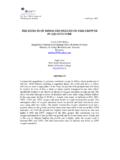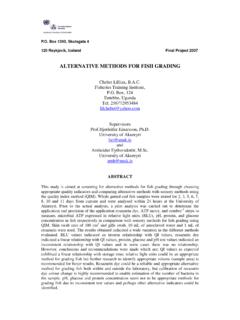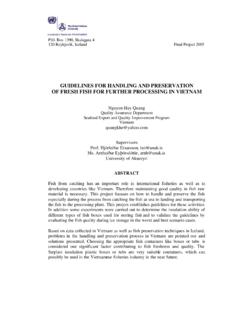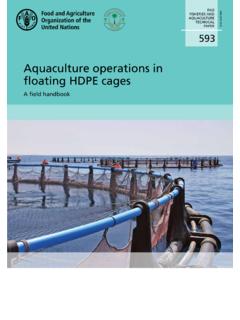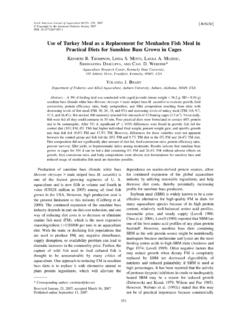Transcription of DESIGN OF A CAGE CULTURE SYSTEM FOR …
1 Box 1390, Skulagata 4. 120 Reykjavik, Iceland Final Project 2003. DESIGN OF A cage CULTURE SYSTEM FOR farming IN. MEXICO. Alfredo Emmanuel V zques Olivares Instituto Tecnologico Del Mar En Mazatl n Carretera Internacional al Sur, Ur as, estero La Sirena s/n Mazatl n, Sinaloa, Mexico. 82150. Supervisor Sigurdur Brynjolfsson University of Iceland ABSTRACT. The increasing world demand for fish cannot be met by capture fisheries. Aquaculture production is increasing and nowadays cage CULTURE has an important role in meeting the world's fish demand. In Mexico, capture fisheries have not increased in recent aquaculture production is mainly inland and the cage SYSTEM for marine fish CULTURE is scarcely used. Based on the necessity to increase fishing production in Mexico, the DESIGN of a cage for CULTURE is proposed that can be developed and built in the country.
2 To accomplish this objective, the following tasks were carried out: a). definition of possible species and sites for farming ; b) definition of DESIGN parameters, and c) proposed cage for farming . The suitability of species was analysed based on biological, marketing and environmental criteria. The site selection was based upon oceanographic and environmental aspects and logistical support for the cage farm. The DESIGN parameters for the cage were based upon experiences of cage farming , as well as on guidelines in papers. The proposal was designed through the definition of major systems: structure and floating, service, net bag, moorings and anchor systems. A floating cage with a netting bag for culturing Black Snook (Centropomus nigrescens) is proposed.
3 It measures 13 m in diameter and 8 m in depth and has a capacity to harvest 17 tons of fish. Black Snook. To encourage this fishery SYSTEM in Mexico, interdisciplinary work will be necessary to tackle the three main issues on cage CULTURE : biological, engineering and socio-economic. In this project, the engineering issue is addressed as part of the necessary knowledge for the implementation of the cage SYSTEM . cage CULTURE could have multiplier effects: provision of jobs for displaced fishermen from traditional fisheries, increased economic inputs, increment fish production and reduced pressure on traditional fisheries, supporting their sustainability. 1. Olivares TABLE OF CONTENTS. 1 2 AN OVERVIEW OF THE cage CULTURE TYPE OF MARICULTURE SYSTEMS.
4 6. IDENTIFICATION OF THE COMPONENTS AND DEVICES OF cage CULTURES ..9. 3 METHODS ..11. 4 RESULTS ..12. DETERMINATION OF CANDIDATE SPECIES TO CULTURE ..12. SITE TO PLACE THE cage ..14. DESIGN PARAMETERS OF THE PROPOSAL OF THE cage FOR CULTURE IN MEXICO ..16. Structure and floating SYSTEM ..16. Service cage Moorings SYSTEM ..21. Anchor Specifications of the cage ..23. 5 ACKNOWLEDGEMENTS ..28. LIST OF APPENDIX 1: MEASUREMENTS OF BRACKET FOR THE HANDRAIL AND CATWALK. ACCORDING TO ANTHROPOMETRY OF THE FISHERMAN IN MEXICO..32. APPENDIX 2: MESH DIMENSIONS AND NET APPENDIX 3: WEIGHT OF THE cage COMPONENTS ..34. APPENDIX 4: FLOTATION FORCE OF THE cage ..38. APPENDIX 5: BALLAST AND TOTAL WEIGHT OF THE cage FOR DIFFERENT. CONDITIONS ..39. APPENDIX 6: EFFECTIVE FLOTATION FORCE OF THE cage .
5 40. APPENDIX 7: CURRENT FORCES APPLIED TO THE COMPONENTS OF THE cage ..41. APPENDIX 8: WIND FORCES APPLIED IN THE SUPERSTRUCTURE OF THE APPENDIX 9: WAVE FORCES APPLIED TO THE APPENDIX 10: GENERAL ARRANGEMENT OF PARTS, DIMENSIONS AND MATERIALS. OF THE MOORING AND ANCHOR SYSTEMS FOR THE UNU-Fisheries Training Programme 2. Olivares LIST OF FIGURES. Figure 1: A classification SYSTEM for cages by way of operating (Beveridge 1996)..7. Figure 2: Gravity cage class (Loverich and Gace 1997)..8. Figure 3: Anchor tensioned cages class (Loverich and Gace 1997)..8. Figure 4: Self-tensioned and supporting cages class (Loverich and Gace 1997)..8. Figure 5: Rigid cages class (Loverich and Gace 1997)..9. Figure 6: Principal components of the cage for farming .
6 9. Figure 8 : The Santa Mar a La Reforma Bay, Gulf of California, site proposed for the deployment of the cage for CULTURE Black Figure 9: Bathymetry of the Santa Mar a La Reforma Bay, Gulf of California (Serrano 2003)..15. Figure 10: Perimeter lengths of different cage shapes for the same surface area and the circular swimming pattern of fish (modified from Beveridge 1996)..17. Figure 11: General view of the proposed cage for farming Black Snook in Mexico. 18. Figure 12: Details of the proposed flotation and ballast pipes made of high-density polyethylene (HDPE)..18. Figure 13: Brackets to hold the flotation and handrail pipes forming the structure of the cage and supporting the floorboards of the catwalk..19. Figure 14: The catwalk around the cage will hold the brackets in its place and will facilitate feeding and Figure 15: Cylinder cage bag with vertical and horizontal ropes for reinforcement and joints with the Figure 16: Moorings and anchor systems proposed for the cage for farming Black Snook in Santa Mar a La Reforma Bay, Gulf of California.
7 22. Figure 17: General arrangement of parts of the Figure 18: Parts and measures of the bracket..36. Figure 19: Approximate measurements of panels for the catwalk..36. LIST OF TABLES. Table 1: Sustainability status of Mexican fisheries in 1997-1998 (INP 2000a)..4. Table 2: Sustainability status by fisheries and species (INP 2000a)..4. Table 3: Classification of cage systems by technical characteristics (Huguenin 1997)..7. Table 4: Characteristics of Black Snook (Centropomus nigrescens) (Bussing 1995, INP 2000a and Quiroga et al. 1996)..13. Table 5: Technical characteristics of the cage for farming Black Snook (Centropomus nigrescens) in Santa Mar a La Reforma Bay , Gulf of California..16. Table 6: Specifications of the cage parts.
8 24. Table 7 : Weight of the cage for different Table 8: Nominal and effective floatation forces of the Table 9: Current forces applied to the cage under different work conditions..26. Table 10: Knot correction factor (k) for different netting panels, Prado, 1990..34. Table 11: Drag coefficients (Cb) for certain body shapes (Fridman 1986)..42. Table 12: Drag coefficients for straight ropes (Cr) according with angle ( ) of the current flow (Fridman 1986)..43. UNU-Fisheries Training Programme 3. Olivares 1 INTRODUCTION. In Mexico, 88% of the total fish production comes from capture fisheries, while inland aquaculture provides 12%. Of the fish caught, 78% comes from the Mexican Pacific, 20% from the Gulf of Mexico and only 2% from inland waters (INP 2000a).
9 The most important species by volume and value are: shrimp, tuna, sardine and squid. The fishing effort has increased considerably in Mexico, causing reduction in fishing stocks and even collapse of some fisheries. Generally, the status of Mexican fisheries is not critical. However the high fishing effort has caused damage in some fisheries like: anchovy, abalone, sea urchin and sea cucumber. Other fish stocks are fully exploited, for example: shrimp, shark, octopus and spiny lobster (Table 1). Table 1: Sustainability status of Mexican fisheries in 1997-1998 (INP 2000a). Gulf of Mexico and Pacific Ocean Inland Waters Caribbean Fisheries Status Fisheries Status Fisheries Status Shrimp Shrimp P tzcuaro Tuna Sharks Small pelagics Tuna Shark Red grouper Oceanic sharks Octopus Giant squid Lobster Abalone Queen conch Lobster Sea urchin Sea cucumber = Development potential = Fully exploited = Over exploited In Mexico, 67% of the fisheries (79% of species) are either fully or over exploited and cannot grow more.
10 This applies to 50% of the fisheries and 51% of species in the Pacific coast and 86% of the fisheries and 97% of species in the Gulf of Mexico and Caribbean Sea (Table 2). Table 2: Sustainability status by fisheries and species (INP 2000a). Fishery status Development Fully exploited Over exploited Total potential Region F Spp F Spp F Spp F Spp Pacific ocean 5 (50%) 32 (49%) 2 (20%) 24 (36%) 3 (30%) 10 (15%) 10 66. Gulf and 1 (14%) 1 (3%) 4 (57%) 26 (90%) 2 (29%) 2 (7%) 7 29. Caribbean Inland waters 1 (100%) 14 (100%) 1 14. Total 6 ( ) 33 (30%) 6 ( ) 60 (46%) 6 ( ) 26 (24%) 18 109. F = Fisheries, Spp = species Due to the critical condition of most of the fish stocks, effort must be directed towards fishing resources that have development potential, with a focus on proposing new alternatives of fish production that does not affect over exploited stocks.

